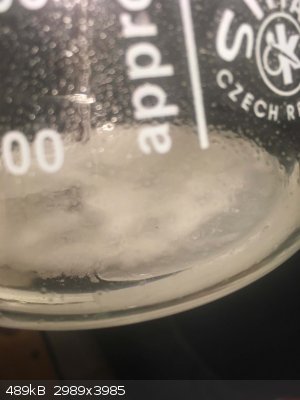| Pages:
1
2
3 |
clearly_not_atara
International Hazard
    
Posts: 2692
Registered: 3-11-2013
Member Is Offline
Mood: Big
|
|
I don't know what planet you live on where methylmagnesium iodide is easier to work with than methanol, but no, you can't do that. Also, TsOH is
water-soluble, while TsCl is not, but tosyl chloride slowly reacts with water. Sulfuryl chloride is not a dehydrating agent and will not convert
alcohols to chlorides; rather, it oxidizes them.
What "alternative" method of making methyl tosylate are you trying to perform, exactly?
[Edited on 04-20-1969 by clearly_not_atara]
|
|
|
KiWiki
Harmless

Posts: 12
Registered: 30-11-2017
Member Is Offline
Mood: No Mood
|
|
Thank you, this makes sense...
The only alternative pathway that remains is the pyridine/MeOH/TsCl pathway. This seems to work in theory.
I have read the entire procedure. Vacuum is not a option as methyl tosylate decompose over 5 mBar.
The good news is that I see indeed a white oil at the bottom of the flask. I think that this compound is methyl tosylate....

|
|
|
AvBaeyer
National Hazard
   
Posts: 644
Registered: 25-2-2014
Location: CA
Member Is Offline
Mood: No Mood
|
|
If you have methanol and tosyl chloride why not just follow the Org Syn procedure described at the very beginning of this thread? Making methyl
tosylate by that procedure is borderline trivial and works every time. No need to distill or otherwise purify the product.
AvB
|
|
|
KiWiki
Harmless

Posts: 12
Registered: 30-11-2017
Member Is Offline
Mood: No Mood
|
|
Interesting, thank you!
If I click on the old link “Org. Synthesis” then I see a lot of subjects but I can’t find the right procedure. What vol., yr., p., (sub)version
OR just the title of this particular subject?
Thanks in advance!
|
|
|
DJF90
International Hazard
    
Posts: 2266
Registered: 15-12-2007
Location: At the bench
Member Is Offline
Mood: No Mood
|
|
http://orgsyn.org/demo.aspx?prep=cv1p0145
See note 4.
|
|
|
clearly_not_atara
International Hazard
    
Posts: 2692
Registered: 3-11-2013
Member Is Offline
Mood: Big
|
|
On the topic of sulfonyl chlorides, they can be obtained by the reaction of anilines with sodium nitrite followed by sulfur dioxide in AcOH containing
HCl, the reaction proceeding most effectively for electron-deficient anilines. The procedure is described in Orgsyn:
http://www.orgsyn.org/demo.aspx?prep=CV7P0508
I can think of a few anilines which are OTC and might be suitable for the procedure, most notably benzocaine, aka ethyl para-aminobenzoate, but also
3-aminopyridine, from the Hofmann degradation of nicotinamide, and 4-amino-2,5-dimethylpyrimidine, from the reduction of thiamin. I am a little unsure
of how the use of heterocycles affects the formation of sulfonyl halides, but usually pyridine and pyrimidine behave like electron-deficient benzene
in aromatic substitutions. Unsubstituted aniline works as well, with lower yield. Para-trifluoromethylaniline might be obtained by rxn of
para-chlorobenzotrifluoride, an ink solvent, with ammonia, though I'm not clear on the details of such a rxn.
This reaction is considered a special case of the Meerwein arylation with diazonium ions, where the substrate is sulfur dioxide. A modification by
Prinsen using dioxane as the solvent claims increased yields on less activated anilines; attached.
Attachment: prinsen1965.pdf (296kB)
This file has been downloaded 375 times
[Edited on 04-20-1969 by clearly_not_atara]
|
|
|
KiWiki
Harmless

Posts: 12
Registered: 30-11-2017
Member Is Offline
Mood: No Mood
|
|
Note 4 seems the same procedure however this complete reaction will take about 8 to 10 hours, not just 4 hours as mentioned by Klute.
First step: Purification of TsCl
Dissolve crude TsCl in bz/tol, wash the organic phase with 5% NaOH to remove TsOH. Dry it over MgSO4 and filter the organic phase again over MgSO4.
Remove the toluene completly by vacuum destillation. Dissolve the solid pure TsCl in DCM (heating required).
After evaporation of DCM the EXACT amount of pure TsCl is necessary to calculate the equimolar amount of 25% NaOH solution.
Because MeOH acts as both solvent and reagens, it’s unimportant to calculate the exact molar ratio of this. Instead use MeOH in excess (follow the
procedure)
Once this reaction is running for hours, you still have a destillation apparatus to start another reaction. I strongly recommend to don’t waste your
time to sit down all the time.
Improvements (second run):
1. Use equimolar amounts of NaOH and TsCl. The only way to do that is to purify TsCl, this takes about 2-3 hours.
2. Once you reach the first neutral point then not all your NaOH is consumed as this reaction proceeds further and continues to release HCl from
unreacted TsCl. Measure the pH every 20 minutes or so and stay adding dropwise 25% NaOH as the reaction continues untill all your 25% NaOH is
consumed.
|
|
|
| Pages:
1
2
3 |